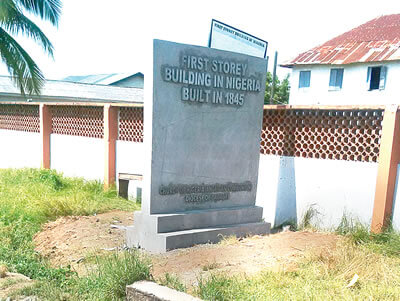Badagry was quite calm on Monday. It was a public holiday and many residents spent the day indoors. Except for the slight queues at ATMs, the horns from the sparse vehicles on the neatly-tarred roads, and the occasional shouts from open spaces where children played football, there was barely any sign of life.
“It’s because of the public holiday,” explained Biodun Seyon, a native of the town who recently graduated from Yaba College of Technology (YABATECH) where he studied Polymer and Textile Technology.
Like many young people who grew up at Badagry, Seyon has learned a trade. He believes that there is something about the historical town that inspires art and creativity in people.
“I make clothes,” he said. “I began a long time ago. While I was in school at YABATECH, I did not depend on my parents because I could take care of myself and my needs with the money that I made. Here, at Badagry, many young people are artisans. There are plumbers, sculptors, painters, carpenters, basket makers, fishermen, boat makers, hairdressers, name it.
“Badagry is special. We have the French Village, the First Storey Building, ASCON, the Slave Market, the Atlantic, the Point of No Return. If you live here, you will want to do great and important things. You will be inspired by history. That is why it is a tourist centre. People come here to be inspired.”
Indeed, according to residents who spoke with Saturday Tribune, earlier in the week, the historical town has been witnessing an influx of tourists, of late.
Abolaji Sewhunde Akande, a publisher, has for many years documented the history of Badagry. Like many natives, he believes that the town holds the key to the future, as there has been a “constant shift” of attention from oil to other sources of revenue. Sitting in his office, a tastefully furnished bungalow, at the heart of the town, he told Saturday Tribune that Nigerians who had often looked beyond the country for their tours were now beginning to notice the treasures in Badagry because of the ongoing recession.
“Actually, recently I have noticed an increase in the number of people coming into Badagry. I believe it is because of the recession. You know there are people who have built the habit of going on tours, so whether there is recession or not, that habit is there. So, such people now have an alternative: it is cheaper to come to Badagry than to go to Ghana or US. I see a lot of people coming in. Tourists are coming, and investments are coming, hotels are built. We now have a three-star hotel at Badagry; we have plans for a theme park; there is now a new zoo.
“What we do from here is just to promote Badagry. We want people to visit Badagry; we want people to have interest in Badagry. We want investors to also see the areas they can explore. Take the proposed sea port, for example.
“But most of these are individual efforts. It would have been better if the government is actually very serious because there is no doubt about it: Badagry has the potential. Individuals who are seeing this potential are the ones who are doing their bits. But it cannot be as organised as it would have been if the government had come in and put the infrastructure. For instance, go to the peninsula at the Point of No Return. That is one of the few peninsulas we have in Africa, where you have the Lagoon and the Atlantic Ocean, side by side. But the facilities are not there. When tourists come, they are disappointed. If you go to the museum, the Slave Heritage Museum, you don’t have enough facilities there. The chairs are dilapidated; there are no instructional materials. It is not the way it should be. And at the Point of No Return, there are no facilities; there is just sand, and there are no facilities to accommodate even the able-bodied tourists, let alone the handicapped ones. The potential is what is keeping the tourism industry in Badagry.”
Local tourists
Opposite the peninsula, along a narrow stretch that appeared to extend endlessly into the distance, is the famous First Storey Building in Nigeria, erected by Anglican missionaries in 1845. The compound also houses a popular well (also built by the missionaries) which continues to serve the community, to this day. Natives say it is the most “natural” source of water in the town, because, in spite of its age, it remains tasteless and odourless.
Mr Ezekiel Viavonu is the Tour Guide of the building. When Saturday Tribune visited, he sat with two men on a wooden bench under a large mango tree.
While narrating the history of the building, the photographs on walls, the bible used by Bishop Ajayi Crowther in the 1800’s, and many other relics which survive from the era, Viavonu said while it may not be desirable for the government to take over the First Storey Building (which is still controlled by the Church), it would help if there was a significant improvement in the economic fortunes of the town.
“What we are attracting are mostly local tourists,” he said. “In fact most of them are students and pupils from secondary and primary schools. But we want to be able to promote Badagry. The government should create more roads to Badagry. There should be a direct link from Costain to this place. The government should explore these opportunities, because tourism cannot stand on its own. It has to depend on massive developments.”
Jewel in the desert
Badagry is unique in many ways. A few places in Nigeria possess the depth, complexity and beauty that enrich the town’s long history. It shares a boundary with Seme, the Nigeria-Benin border, and sits beside the Atlantic.
The story of Badagry is writ large at every corner of the town. Natives easily recount their families’ histories, stories of conquest and survival. A couple of museums preserve some of the relics of the era. Mobee Slave Relic Museum and Badagry Heritage Museum are two of them. There is also the Vlekete Slave Market established in 1502, and Agiya Tree Monument, where Christianity was first preached.
The first Primary School in Nigeria also stands at Badagry. Established by Weslyan Mission (the Methodist Church) in the 1800’s, it was called Nursery of the Infant Church.
Global
However, according to the the Public Relations Officer, Lagos State Ministry of Tourism, Arts and Culture, Mr Ganiu Lawal, Badagry is a part of a larger programme designed by the State Government to place Lagos on a “global tourism map”.
“If you go to the Point of No Return, there is a construction work going on there to extend those coastal lines,” he said. “And there is also the museum. The museum is currently being put in good shape. And there are so many other projects and plans by the State government to encourage tourism in Badagry.
“This government has a policy on tourism, hospitality, entertainment, and sports for excellence and these have been pursued vigorously since the Governor came in. We have the Lagos Marathon which draws many athletes from other countries; we also have the One Lagos Fiesta which now takes place in five locations across the State. It was five days last Christmas season; this time around it is eight days. So these are all tourism-related programmes that are essential to populate our tourism calendar, such that every month, something is happening in Lagos, people are coming in, consumption pattern is increasing, locally produced goods are being sold, food is available, food-sellers are selling, artisans are making money”, Lawal said.







